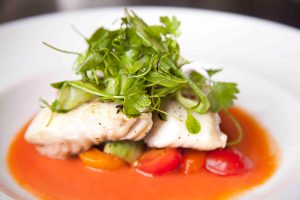Within the hallowed halls of fine dining establishments, a careful alchemy of elements combines to create an enchanting and refined ambiance. The air is alive with an understated elegance, where soft lighting casts a warm glow upon polished silverware, and immaculate linens drape tables with precision. The artful interplay of colors, textures, and carefully selected furnishings sets the stage for a dining experience beyond nourishment, immersing guests in a world of sophistication and luxury.
But it is not just the visual tapestry that distinguishes fine dining; the mastery of culinary craftsmanship truly sets these establishments apart. Behind the scenes, skilled chefs harness their expertise and creative vision to orchestrate a symphony of flavors. Each dish is a testament to meticulous planning, sourcing the finest ingredients, and applying culinary techniques honed through years of dedication. From delicate amuse-bouches to decadent desserts, every plate presented is a work of art, tantalizing the taste buds and leaving a lasting impression.
Join us on this captivating journey as we delve into the key elements that define fine dining restaurants. From the meticulously crafted ambiance to the mastery of culinary artistry and the seamless service, we unravel the secrets that elevate these establishments to the pinnacle of gastronomic excellence. Prepare to be enthralled by the world of fine dining, where every bite is a revelation, and every moment is an indulgence in the pursuit of culinary perfection.

The Art of Creating an Experience
Fine dining is not just about the food but rather the entire experience. From the moment customers walk through the door, they should feel like they are entering a different world. It requires attention from the ambiance and decor to the lighting and music.
Ambiance and Atmosphere
The ambiance and atmosphere of a fine dining restaurant play a crucial role in setting the tone for the dining experience. Several things contribute to the creation of a luxurious and refined environment, including:
Lighting design that creates a sense of intimacy and warmth
- Soft, warm lighting can create a cozy and inviting atmosphere, while brighter lighting can give the restaurant a more energetic and lively vibe.
- Lighting can also be used to highlight certain elements of the restaurant, such as artwork or architectural details.
Beautifully crafted table settings accentuate the elegance of the restaurant
- Fine dining restaurants often use high-quality linens, crystal glassware, and polished silverware to create a sense of luxury and refinement.
- Table settings may include decorative touches such as flowers, candles, or unique place settings.
Thoughtful decor and aesthetic choices that provide a cohesive and luxurious feel
- The decor of a fine dining restaurant should complement the overall vibe and style of the restaurant.
- It includes elements such as artwork, sculptures, or unique architectural features.
Attention to Detail
Exceptional service is another key element that creates a memorable dining experience. Restaurants that prioritize attention to detail will take extra care to ensure that every element of the dining experience is perfect.
Exceptional service that makes diners feel important and valued
- Waitstaff should know the menu and wine list and can answer questions or make recommendations.
- Service should be attentive but not intrusive, with waitstaff available when needed but not hovering.
Thoughtful menu options that cater to dietary restrictions, food allergies, and preferences
- Fine dining restaurants should be able to accommodate various dietary restrictions and preferences, such as vegan or gluten-free options.
- Chefs may also be willing to customize dishes based on individual tastes.
Special touches such as personalized menus or amuse-bouche’s
- Some fine dining restaurants may provide personalized menus or specially crafted amuse-bouches (small bite-sized appetizers) to create a unique experience for diners.
Immersive Experience
Finally, many fine-dining restaurants aim to provide an immersive experience that transports diners to another place or time. It includes such as:
An atmosphere that transports diners to another place or time
- The restaurant’s decor, lighting, and music can all work together to create a specific atmosphere that evokes a particular time or place.
- Restaurants may also use scents or fragrances to enhance the overall sensory experience further.
Music choices that create a particular ambiance or mood
- The music played in a fine dining restaurant should complement the restaurant’s overall vibe and create a relaxed and enjoyable atmosphere.
Elements of surprise or fun that create a memorable experience
- Some fine dining restaurants may incorporate live music, tableside preparations, or special events to create a truly unforgettable experience for diners.

Elevated Service
Service is another key element that differentiates fine dining restaurants from others. Attentive, personalized, and discreet service can make diners feel special and elevate the overall experience.
Personalized Attention
One of the hallmarks of elevated service in a fine dining restaurant is the personalized attention given to each guest.
Knowledgeable waitstaff that can answer questions about the menu or wine list
- Fine dining restaurants often have highly-trained servers knowledgeable about the available food and beverage options.
- They can offer detailed information about the ingredients used in a particular dish or recommend a wine pairing.
Consistent service that is attentive but not intrusive
- Waitstaff should be available to guests when needed but not overly present.
- Service should be seamless, with dishes arriving at the table at the appropriate time and courses flowing smoothly.
Attention to detail, such as keeping glasses filled and removing dishes discreetly
- Waitstaff should be attentive to the needs of each guest, ensuring that water glasses are always filled, and dishes are cleared promptly and quietly.
Anticipating Needs
In addition to personalized attention, elevated service in a fine dining restaurant often means anticipating guests’ needs before they even ask.
A trained team that can anticipate what diners need before they even ask
- The best fine-dining restaurants have intuitive servers to anticipate each guest’s needs.
- It includes bringing a blanket to a chilly guest or offering to refill a drink before the glass is empty.
Making recommendations based on preferences or past dining experiences
- Servers may be able to make recommendations based on a diner’s previous dining experiences at the restaurant or their particular preferences or dietary restrictions.
Offering special touches such as complimentary dessert or a tour of the kitchen
- Fine dining restaurants may offer special touches such as a complimentary dessert for a special occasion or a kitchen tour to give guests a behind-the-scenes look at the culinary process.
Unexpected Surprises
Finally, elevated service in a fine dining restaurant can often mean providing surprises that make the dining experience even more memorable.
Surprise elements to the meal, such as amuse-bouches or palate cleansers
- Fine dining restaurants may offer small bites or palate cleansers between courses to keep the dining experience interesting and surprising.
Personalized touches such as customized menus or handwritten notes
- Some restaurants may provide customized menus with a diner’s name or message printed on them or a handwritten note from the chef or staff.
Surprising gestures such as sending out a dish that’s not on the menu or providing a complimentary course
- Fine dining restaurants may surprise guests by sending out a dish not on the menu or providing a complimentary course to enhance the overall dining experience.

Culinary Creativity
The essential component of fine dining, high-quality food, and drink, is what customers come for. Using fresh, premium ingredients and crafting visually stunning and delicious dishes is a hallmark of any fine dining experience.
High-Quality Ingredients
The foundation of any great dish is high-quality ingredients. Fine dining restaurants pride themselves on sourcing the best possible ingredients worldwide.
Sourcing top-quality ingredients from reputable purveyors
- Chefs in fine dining restaurants often have relationships with specialty purveyors who provide unique ingredients such as exotic spices or rare fruits.
Using locally-sourced, seasonal produce and proteins
- Many fine-dining restaurants prioritize using locally-sourced and seasonal ingredients to ensure freshness and support local farmers and producers.
Incorporating specialty ingredients that are hard to find or rare
- Some fine dining restaurants may incorporate specialty ingredients such as truffles, caviar, or edible flowers to add unique flavors or visual elements to the dish.
Innovative Techniques
Fine dining chefs are known for experimenting with new cooking techniques and finding innovative ways to present dishes.
Embracing new cooking methods such as sous-vide or molecular gastronomy
- Sous-vide cooking involves placing food in a vacuum-sealed bag and cooking it at a low temperature for an extended period to create a perfectly cooked dish.
- Molecular gastronomy is a cooking technique that uses science and technology to create unique textures and flavor combinations.
Utilizing traditional techniques in innovative ways
- Fine dining chefs may put a new spin on classic techniques such as braising or roasting to create unique and unexpected flavors.
Experimenting with flavor combinations and textures that are unexpected
- Some fine dining chefs may experiment with unusual flavor combinations or textures to create surprising and memorable dishes.
Attention to Presentation
Finally, presentation is a key component of any great fine dining experience. Dishes should be visually stunning and beautifully presented.
Creating visually stunning dishes that are as beautiful as they are delicious
- Fine dining chefs often use color, texture, and shape to create visually stunning dishes that are as much a feast for the eyes as for the palate.
Careful attention to plating, with a focus on symmetry and balance
- Plating is an art form in fine dining, with chefs carefully arranging ingredients to create a balanced and visually appealing dish.
Incorporating elements of texture and color into each dish
- Fine dining chefs may incorporate elements such as edible flowers or microgreens to add pops of color to a dish or use contrasting textures to create a dynamic and interesting plate.
Fine dining restaurants are not just about the food but about creating a memorable experience. From the ambiance and decor to the service and culinary creativity, every aspect of a fine dining restaurant is carefully crafted to transport customers to a world of luxury and refinement. With attention to detail, personalized service, and culinary innovation, fine dining restaurants offer a unique experience not easily found elsewhere.
If you’re looking for a one-of-a-kind dining experience, consider visiting one of your local fine dining restaurants. Pay attention to the ambiance, the menu options, and the service. Take note of the high-quality ingredients used and the innovative techniques employed by the chefs. Treat yourself to a night of luxury and refinement, and see why fine dining has become such a coveted experience.

